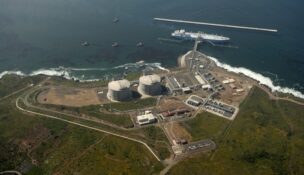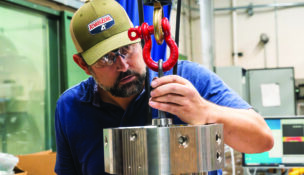10.10.10 Launches Cities Program Focused on Water and Infrastructure
Local entrepreneurial initiative invites 10 global entrepreneurs to develop market-based solutions to "wicked problems"
ColoradoBiz Staff //October 16, 2017//


10.10.10 Launches Cities Program Focused on Water and Infrastructure
Local entrepreneurial initiative invites 10 global entrepreneurs to develop market-based solutions to "wicked problems"
ColoradoBiz Staff //October 16, 2017//

After three years of programming in the health sector, Denver-based 10.10.10 nonprofit that seeks to match entrepreneurs with "wicked problems," launches its "Cities" program, focusing on water and infrastructure challenges, Monday, October 16.
With urban populations growing exponentially – jumping from 10 percent of the world's population in cities to 54 percent today – the unique challenges of living in cities are only getting more serious.
Inviting 10 global entrepreneurs to the Mile High City to participate and envision market-based solutions, the program is called a "venture accelerator."
We talked to Tom Higley, 10.10.10's CEO and founder about the new program:
What was the inspiration for 10.10.10 Cities?
TH: From its inception in 2012, 10.10.10 has focused on inviting successful entrepreneurs to create market-based solutions to wicked problems in health, water, food, energy, learning, infrastructure, waste security and climate change. Two years ago we began to understand that something very important was taking place throughout the world. At the turn of the last century, just 10 percent of the world's population lived in urban areas. Today, more than 50 percent of teh world's population is to be found in urban areas. This number is expected to reach 66 percent by 2050. This means that throughout the world wicked problems in health, water, infrastructure, etc. are going to be experienced – and addressed – in urban areas. Cities need an alchemy – one that actually works – by which wicked problems are transformed into opportunities.
How will this new program work? When will it launch? For how long?
The new program is not different than the 'old' program. Our first program in February 2015 focused on wicked problems in health. To make the program work, we need to do a few things well:
- Identify wicked, research and present problems
- Identify exceptional serial entrepreneurs from throughout the U.S. who planned to start new ventures within the next year
- Identify large organizations and institutions that understand both the systems within which these wicked problems tended to cluster as well as the problems themselves
- Bring all these elements and stakeholders together in a way that engages and challenges the community
We began to work on our 10.10.10 Cities 2017 program the instant we finished our 10.10.10 Health program in June of this year. We knew we had very little time to prepare. We had to identify the large organizations and institutions that understood and cared deeply about water and infrastructure. We had to identify a new cohort of successful serial entrepreneurs and select just 10 of them. We had to develop the 10 wicked problems, research them and present them to a large audience via 10 Problem Advocate ideas. Those who attend our big reveal Monday, October 16 at 4 p.m. at McNichols Civic Building will learn for the first time which problems we've selected and just who we've invited to become part of the group of 10 prospective CEOs. The program reaches its conclusion October 26, when each of the prospective CEOs presents at our finale – 4 p.m. at The Cable Center. But in reality it continues long after October 26. Each of these prospective CEOs will use what they've learned to explore the wicked problems and may take up to a year to create their next new venture.
What are the goals of this program? What already exists in this realm, and how is 10.10.10's programming different?
…10.10.10 has two key goals.
- We want serial entrepreneurs to approach the start of their next ventures in a much better way. They are investing the next chapter of their lives – five, 10, even 15 years – in their next venture. They needed a much better way to approach this process. We provide that.
- We have come to understand that certain complex adaptive systems give rise to wicked problems that will not be addressed by government or large industry. Entrepreneurs bring a unique perspective and powerful assets and skills to these problems. They can become a key way to bring extraordinary new solutions to market.
Most of the startup world has focused – for the past 10 years – on what happens after a new venture is created. We speak about this as a bowtie where the knot in the bowtie is the moment a new venture is created. The right side of the bowtie has gotten all the attention. This is where accelerators like TechStars or Y Combinator live. This is where the lean startup movement lives with its focus on customer development and MVP (minimum viable product).
10.10.10 is focused on the left side of the bowtie – the process that founders go through as they explore the creation of a new venture. As far as we know, 10.10.10 is unique in this focus. It is not modeled after something others created. This got its start right here in Denver, and at scale we expect the program to be operating in at least 10 cities throughout the U.S. and ultimately throughout the world.
What is the significance to Colorado? Can you describe the key players in Colorado> What about the local issues?
Colorado is where we live and where we started. And Denver may be the best city in the world in which to live, learn, work and play. We were supported from the start and are still supported by an exceptional partner – The Colorado Health Foundation. We now are delighted to be able to work closely with the Walton Family Foundation and the Gates Family Foundation. And Colorado, as you may know, has a powerful role as headwaters state in understanding, establishing and maintaining a wise, sustainable approach to water management and use. This is made clear in this excerpt from the Colorado Foundation for Water Education.
The headwaters of four major rivers draw from the mountains within Colorado’s borders. But while this water may originate in our state, it flows through 18 other states and the Republic of Mexico, and we must leave water in the rivers for their use, too. Colorado has nine interstate compacts, or agreements, that determine how much water we must leave for our neighbors. If climate change results in less water, Colorado and its fellow compact states will have less water to divide between them, and less water to use.
In a very real sense all of these wicked problems are local issues. Mayor Michael Hancock has realized this and taken steps to do something about it with “A Plan to Repair & Improve Denver’s Infrastructure.” The voters will address Bond measures 2A through 2G in next month’s election. Infrastructure is a local issue. Water is a local issue. You’ll pardon me if I used the “F” word here – and that word, of course is “Flint.” Flint demonstrates the criticality of these issues. Nothing could be more local.
This is why we are so happy to have Denver Water as a participant in this program. They’ve been forward thinking and exceptionally well-managed for decades. But we explore critical local issues in the context of the larger issues and trends that will inform and shape the experience of cities throughout the country and the world. Cities will learn, as a part of 10.10.10, about the challenges and approaches that are common to cities and the challenges and approaches that are unique to a particular city. And this is what our serial entrepreneurs want to learn about – at speed – as they explore the creation of a new venture that will address a wicked problem related to infrastructure or water.
Why expand 10.10.10's programming/priorities now?
It has become clear to many that government, particularly at the national level, cannot be expected to address these wicked problems. As we begin look to regional and local initiatives, we find in the entrepreneur a resource that has been underutilized. They are magnets for capital and talent. They know how to build new businesses. Every city should be thinking about how to harness the capabilities these entrepreneurs bring to the table.
Over the past three years, 10.10.10 has learned a lot about how to deliver value to serial entrepreneurs and to the large organizations and institutions that support them in understanding and addressing problems. We expected, from the very beginning, to do this throughout the U.S. and around the world. Serial entrepreneurs need for a better “new venture generation” process has only grown during this time period. And the wicked problem areas we identified at the start continue to provide our entrepreneurs with exceptional challenge and opportunity. It has become abundantly clear that cities are now primed to support the approach we’ve worked to create.

























